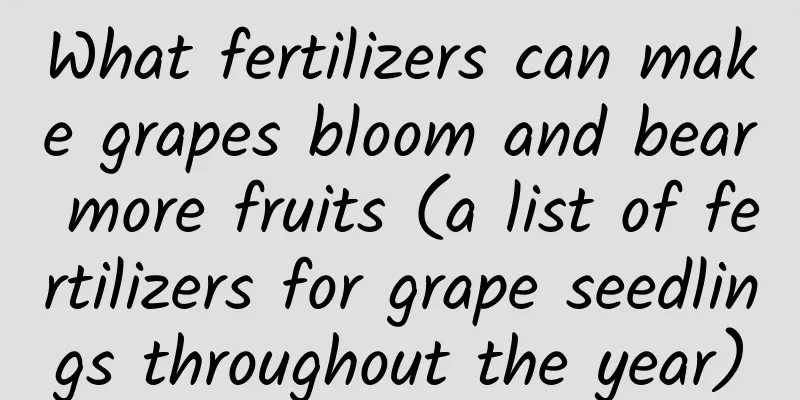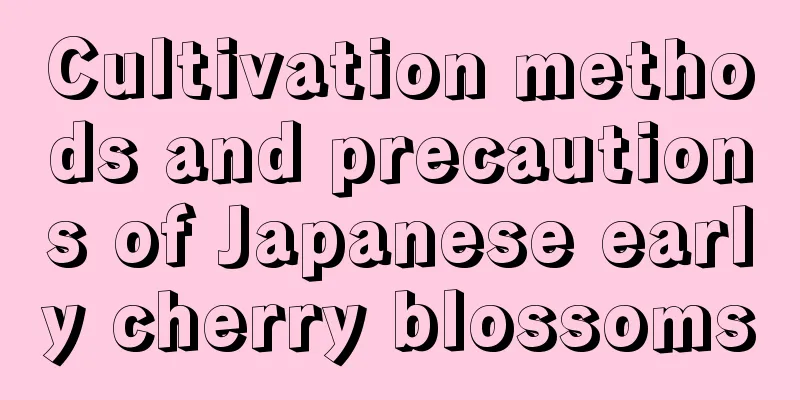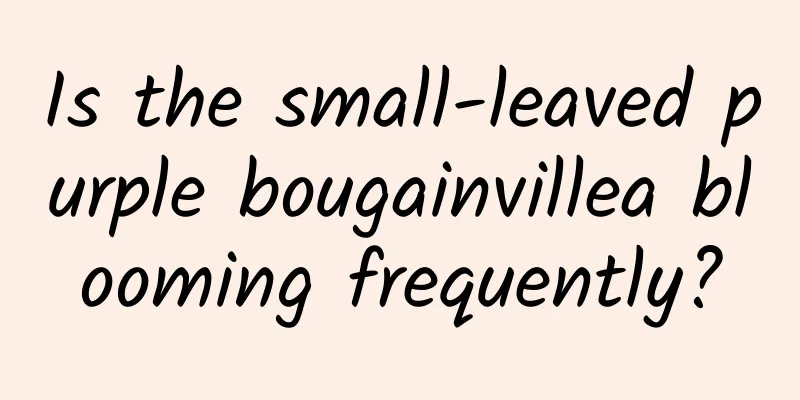What fertilizers can make grapes bloom and bear more fruits (a list of fertilizers for grape seedlings throughout the year)

|
There are many factors involved in making the branches full of grape fruits, but fertilization is definitely a very important part of it. During the period from budding, leafing, flowering to the first expansion period of young fruits, grapes have a greater demand for nitrogen fertilizer; during the period of vigorous growth of new shoots and berry expansion, they have a greater demand for phosphorus; and from the period from fruit coloring to maturity, they have a greater demand for potassium . Therefore, fertilization should be targeted according to the needs of grapes in different growth stages. According to the purpose and time of fertilization, we can divide grape fertilization into two forms: base fertilizer and topdressing. What kind of base fertilizer should be applied to make grapes grow well?Basal fertilizer includes basal fertilizer applied in planting furrows and basal fertilizer applied in autumn, and their purposes are different. The purpose of basal fertilizer applied in planting furrows is to improve the soil environment of the orchard and increase the organic matter in the soil. The purpose of applying basal fertilizer in autumn is to increase the accumulation of nutrients in the tree and promote the growth of the grape root system. The following is a detailed introduction on how to apply basal fertilizer in autumn. ① Types of basal fertilizer The base fertilizer should be mainly farmyard manure or commercial organic fertilizer, supplemented by chemical fertilizers such as superphosphate, potassium sulfate, and medium and trace element fertilizers. ② Time to apply basal fertilizer to grapes in autumn Theoretically, basal fertilizer can be applied after the grapes are harvested and before the soil freezes, but based on production experience, the best effect is achieved by applying basal fertilizer immediately after harvest. ③Methods of applying basal fertilizer The method of applying basal fertilizer in different grape producing areas is different, but it is mainly fertilized in ditches or holes, which is usually done once every 1 to 2 years. The specific method is to dig ditches or holes about 40 cm on both sides of the grape plants every other year, with a depth of 50 to 60 cm, and then fertilize and fill in in time. ④Amount of basal fertilizer It is generally recommended that for an orchard with an annual grape yield of 1,000 kg per mu, a base fertilizer dosage of about 4,000 kg can meet the basic production needs of the grapes. ⑤Precautions when applying basal fertilizer (1) The organic fertilizer in the base fertilizer must be fully decomposed and fermented, and must be mixed evenly with the soil when applying it. The two base fertilizers should be applied to different parts of the soil. (2) When digging fertilizer trenches or holes, avoid damaging the thicker roots. (3) Water thoroughly after fertilizing. (4) In areas where the soil needs to be buried in winter to protect against the cold, base fertilizer is generally not applied in autumn, but should be applied in spring. List of topdressing and fertilization for grapes throughout the yearThe nutrient supply of grapes throughout the year can be basically met by applying basal fertilizer. However, it is still necessary to apply topdressing to grapes based on the different nutrient requirements of grapes at different growth stages, mainly quick-acting fertilizers. Topdressing can be divided into root topdressing and foliar topdressing. 1. Root topdressing Root topdressing can be done with single-element fertilizers or compound fertilizers according to the actual needs of grape growth. (1) Timing of root topdressing According to the fertilizer requirements of grapes at different growth stages, root topdressing can be divided into the following times:
(2) Methods of root topdressing It is recommended to use drip irrigation for fertilization, which is more uniform and accurate; if conditions are not met, it is best to use furrow fertilization or hole fertilization. The method of flushing with water during flood irrigation has the worst effect. (3) Dosage of root topdressing Fertilization varies in different regions and due to different soil fertility, which to a certain extent depends on the accumulation of local planting experience. Generally speaking, every 1,000 kilograms of grapes produced require 3 to 6 kilograms of nitrogen, 1.5 to 2.8 kilograms of phosphorus, and 3.6 to 6.8 kilograms of potassium. The following is an example of a fertilization plan developed for a customer in Zhangye, Gansu. The vineyard has a row spacing of 3.5 meters, a plant spacing of 0.5 meters, and a grape yield of about 900 kilograms per acre. The fertilization plan is divided into three times of fertilization throughout the year.
(4) Issues that should be paid attention to when applying topdressing When applying topdressing, you should keep a distance of 30 to 50 cm from the grape plants, apply nitrogen fertilizer shallowly, and apply phosphorus and potassium fertilizers deeply. Water should be applied immediately after fertilizing. 2. Foliar fertilization of grapes It can be said that foliar fertilization has a multiplier effect. It is economical and labor-saving and can be quickly absorbed by grapes. It is particularly effective in treating nutrient deficiencies. (1) Types of fertilizers for grape root topdressing The fertilizers suitable for foliar fertilization mainly include urea, superphosphate, potassium dihydrogen phosphate, water-soluble compound fertilizers and medium and trace element fertilizers such as chelated calcium, calcium sugar alcohol, borax, zinc sulfate, ferrous sulfate, etc. (2) Time for applying fertilizer to grape roots Generally speaking, foliar fertilizer can be sprayed during the growing season of grapes, but it is best to spray according to the fertilizer requirements and growth conditions of the grapes. That is to say, during the critical period when grapes need certain elements the most, spraying the most needed fertilizer will have the best effect. For example, nitrogen fertilizer can be sprayed from leaf expansion to flowering; phosphorus fertilizer can be sprayed during the fruit expansion period; potassium fertilizer can be sprayed during the fruit coloring period. When trace elements are deficient, spray accordingly. (3) Methods of applying fertilizer to grape roots Focus on spraying on leaves and new shoots. (4) Frequency of fertilization of grape roots Nitrogen, phosphorus and potassium can be sprayed 1 to 3 times during a growing season. The three can be sprayed separately or mixed. (5) Matters needing attention when applying fertilization to the roots of grapes Foliar fertilizer should be used as soon as it is prepared; when spraying, it should be sprayed evenly and the number of spraying times should be sufficient; when mixing several foliar fertilizers, be sure to pay attention to the acidity and alkalinity of the fertilizers to avoid reducing the fertilizer efficiency or causing fertilizer damage, especially when applying some new foliar fertilizers, you must strictly follow the instructions. It should be noted that although fertilization has a great impact on grape yield, while doing a good job of fertilization management, we must also pay attention to the management of soil, light temperature, water, etc. Only when all aspects are adapted to the growth of grapes can we ensure a high yield and harvest of grapes. |
>>: When and how to plant coriander in winter (master these 4 steps to grow high-quality coriander)
Recommend
What soil is best for bonsai?
The key to growing bonsai flowers is to provide a...
Why can't I grow flowers and plants well in hydroponics?
Reasons for root rot and yellow leaves of hydropo...
Planting method of Phellinus igniarius
Coriolus versicolor is a common Chinese medicine....
What are the varieties of Cymbidium?
Historical varieties Traditional Cymbidium orchid...
Can lucky bamboo be grown in soil? Introduction to soil growing methods
1. Lucky bamboo can be grown in soil Lucky bamboo...
The meaning of white palm
1. Meaning The flower language of white calla lil...
Can I grow gardenias at home?
Can I grow gardenias at home? Gardenia can be gro...
The best time to plant Magnolia grandiflora
Magnolia grandiflora is a plant of the genus Magn...
Environmental conditions and characteristics of litchi growth
Litchi growth environment conditions and requirem...
How to sow Globe amaranth
Globe amaranth seedlings grow slowly and are usua...
What do 19 roses represent?
1. Love forever Among the 19 roses, 19 sounds the...
Is Cordyceps profitable? Benefits and profits of planting
Is it profitable to grow Cordyceps? Growing Cordy...
How often should banyan trees be watered? Watering precautions
How often should you water your banyan tree? When...
The succulents in her home have gone through a lot of changes, from ugly and green to beautiful. What has they experienced?
The little one grows up Most flower lovers are at...
How long is the growth cycle of bougainvillea?
Introduction to the growth of bougainvillea Bouga...









